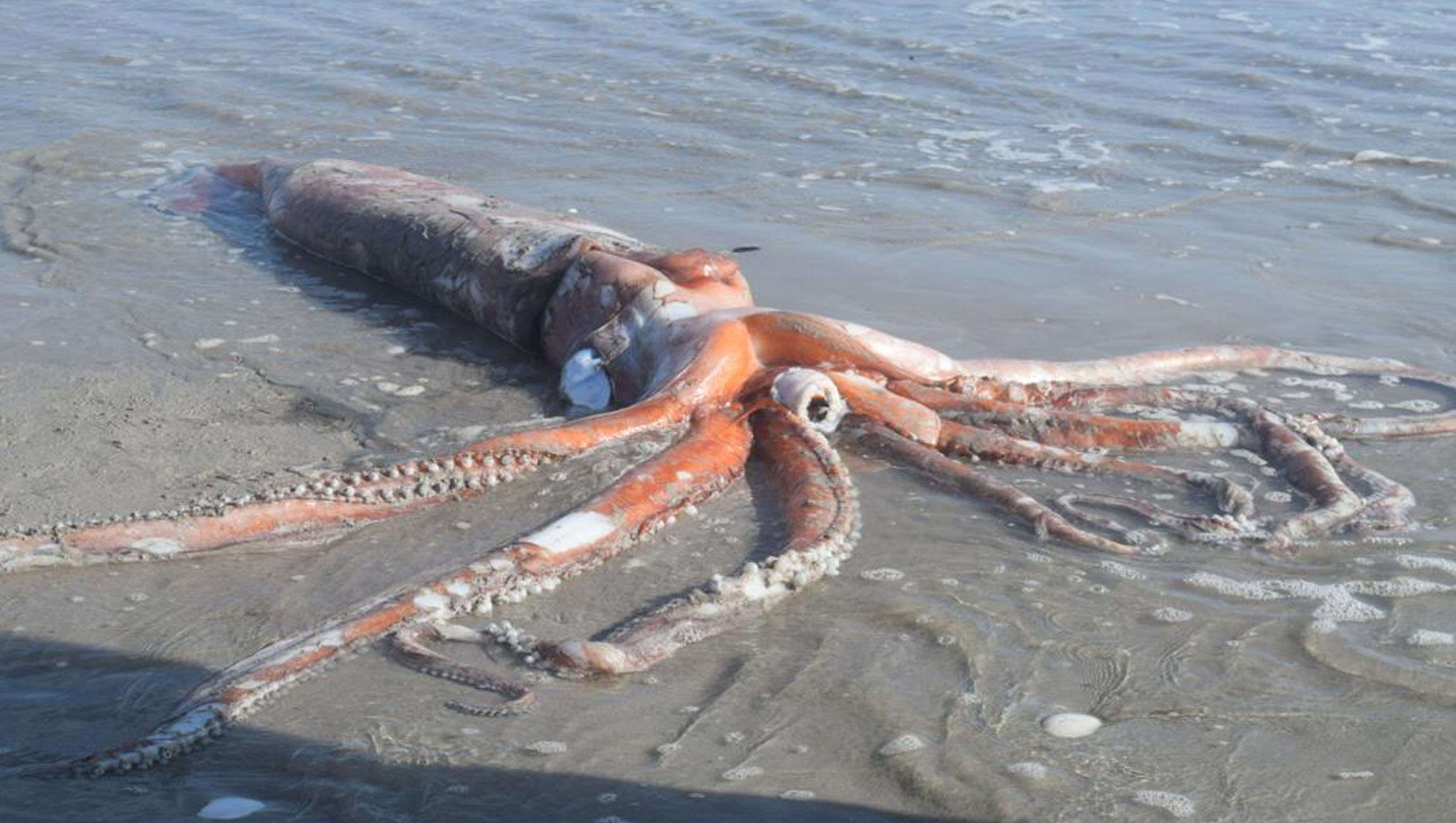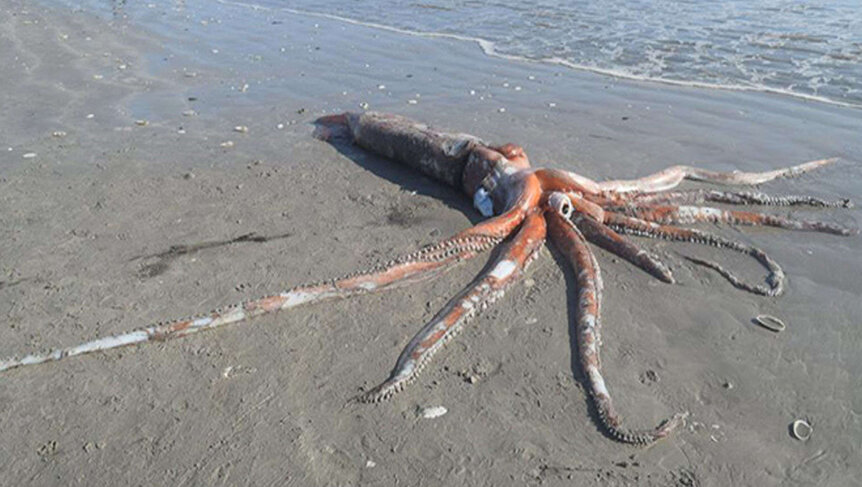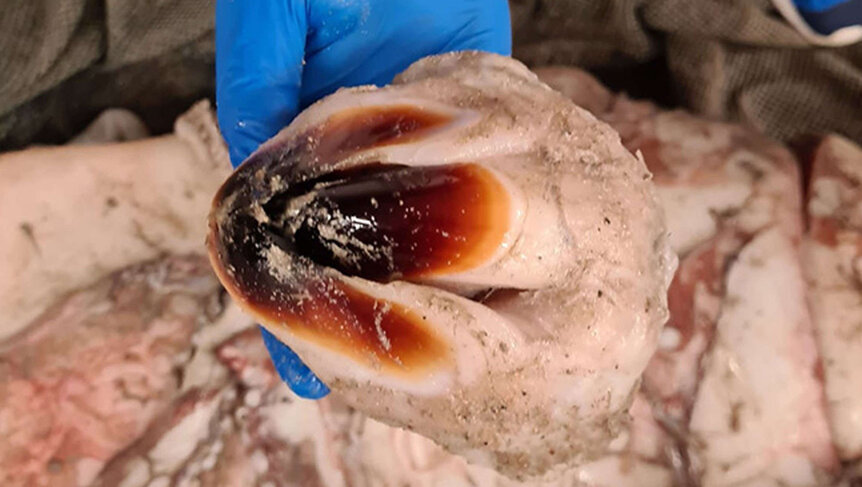Create a free profile to get unlimited access to exclusive videos, sweepstakes, and more!
What a giant squid that washed up intact can tell us about this elusive real-life Kraken

Myth and legend have turned the giant squid into the monster otherwise known as the Kraken, but we actually know little about this creature of the deep that only surfaces—or washes up—occasionally.
Not only did the waves end up bringing the beast to shore, but it was intact. Specimens of giant squid (Architeuthis dux) that haven’t been torn apart by predators or decomposition are extremely rare. The squid was recently found on Golden Mile Beach in Brittania Bay, South Africa and quickly picked up by scientists from Iziko South African Museum’s Marine Biology Unit to add to the museum’s collection. It has already been measured and had DNA samples extracted. It is now temporarily chilling out in the museum’s walk-in freezer, which keeps it at -22 degrees Fahrenheit.
Something like this won’t be forgotten in the freezer. As soon as the pandemic lockdown restrictions start to ease up, a thorough study will be conducted on the 13-foot-long squid before it is preserved in formaldehyde and added to the museum’s wet collection. At least nineteen other Architeuthis specimens are residents of Iziko’s impressive collection. It is one of the largest repositories for giant squid on the planet, and its most massive giant squid specimen is 30 feet long, which is still nothing compared to the largest specimen ever found, which was 59 feet long and weighed about a ton. It remains unknown whether giant squid can grow even larger than that leviathan.
Giant squid are the largest invertebrates on Earth, not to be confused with the heaviest, the colossal squid, which is literally a whole different animal. Mysteries about Architeuthis dux are still afloat. How does it hunt? What does it hunt? If it lives in total darkness, can it change color? Is it bioluminescent? How huge could it really get? Some of these questions have fragmented answers that might be pieced together with further study on this remarkably intact specimen.
What we do know about giant squid mostly comes from dissections and behaviors of other species of squid and cephalopods. Squid propel themselves by sucking water into their mantle through a funnel and pushing it back out into a high-powered jet stream. Because of its size, giant squid is thought to burn so much energy doing just this that scientists have explained its massive energy expenditure as the reason for its three hearts. Yes, this thing has more hearts than Doctor Who. It has one systemic (main) heart and two branchial hearts. The branchial hearts pump blood to its enormous gills, which receive oxygen from the water through osmosis. That oxygenated blood then rushes to the systemic heart. By the way, that blood is blue.
The brain gets even weirder. Food will actually pass through the squid's donut-shaped brain, which surrounds its esophagus. What goes in also comes out pretty close to where it went in. Got that?
Most cephalopods have the almost supernatural ability to change color. Squid are actually colorblind (which makes it ironic that they are thought to have some of the largest eyes in the animal kingdom). Structures under their skin called chromatophores, iridophores and leucophores adjust to the levels of different types of light around them, and bumpy structures called papillae can change the shape of the animal to blend in with coral, algae, seaweed and just about anything else to camouflage it from predators. Squid can also gush ink as a last resort to confuse anything that is hunting them. But do you really need to blend in with anything when you live in the Twilight Zone of the ocean at least 2,000 feet deep?
Scientists who dissected a giant squid and examined samples of its skin under a microscope found chromatophores. This suggests the species probably can change color, though whether its ability has become vestigial after millions of years in the darkness remains unknown. However, scientists dissecting this beast have also found a pair of photophores—bioluminescent organs that light up. So the squid apparently has a light show it can activate.
Giant squid have never been caught hunting and feeding on camera. The closest we’ve gotten is an unreal video of one of these predators grasping bait used to lure it. What scientists do know about smaller squid is that they dart out and grab small fish and other prey with their tentacles, then tear it apart with their hard beak and a spiked tongue called a radula. Now imagine something gargantuan shredding much larger fish, other outsize mollusks and even small whales. What is still unclear is whether they enjoy the thrill of the chase or ambush their prey. The size of this creature makes it more likely to be an ambush predator that sneaks up on its dinner and then has a feast. Its feeding tentacles, which are the two longest, actually have teeth embedded in the suction cups. Anything caught in that can’t get away.
While giant squid sound like they might not face any predators themselves (even a shark apparently tried and failed), sperm whales gorge on them. Dead whales that have landed ashore were found to have squid beaks in their stomachs. There was even one study that involved attaching a camera to a sperm whale in order to get footage of the giant squid it craves.
Perhaps one of the strangest things about this already bizarre animal is how it mates. There is nothing romantic about what scientists have been able to figure out about giant squid mating, and if there was a soundtrack, it would be headlined with Love Hurts. The male uses a specialized tentacle to stab the female with a packet of sperm to fertilize her eggs. She then produces a viscous substance she mixes the eggs with inside her body before injecting them with that sperm. She will lay them all at once before her life’s work is finished and she dies.
Maybe the new, intact specimen acquired by the Iziko Museum will expose more about this mysterious mollusk. Most samples that have drifted to shore have been female. There are aspects of male physiology and behavior that are still waiting to be discovered, but no one knows much about the new specimen yet. For now, giant squid remain an enigma.





























